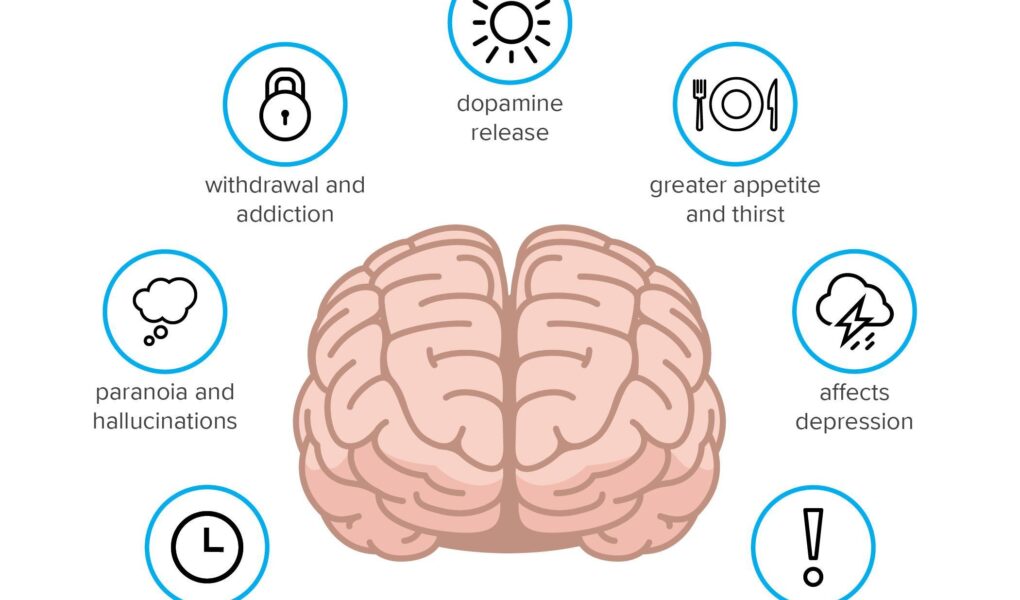Title: “The Other Side of the High: Unpacking the Side Effects of Weed”
Introduction:
As the green wave of cannabis legalization sweeps across continents, more people than ever are exploring the myriad benefits of this ancient plant. From pain relief to anxiety reduction, the potential advantages of cannabis are often celebrated in glowing terms. However, like any powerful substance, the effects of weed are not universally positive. Beneath the euphoria and relaxation, a landscape of side effects can emerge—some subtle, others more pronounced. In this article, we will delve into the lesser-discussed consequences of marijuana use, examining how this beloved herb can impact both the mind and the body. Join us as we navigate the complex interplay between cannabis and its effects, shedding light on the importance of informed consumption.
Table of Contents
- Understanding the Physiological Reactions to Cannabinoids
- Exploring the Psychological Impact of Marijuana Use
- Navigating the Long-Term and Short-Term Side Effects
- Practical Tips for Minimizing Unwanted Experiences with Cannabis
- Q&A
- To Wrap It Up
Understanding the Physiological Reactions to Cannabinoids
The body’s endocannabinoid system (ECS) plays a crucial role in mediating the effects of cannabinoids, influencing various physiological processes. When THC, the psychoactive component of cannabis, interacts with cannabinoid receptors, it can lead to a range of responses. Some of the most common physiological reactions include:
- Altered Mood: Users may experience euphoria or relaxation, but can also feel anxiety or paranoia.
- Increased Heart Rate: Heart rates may accelerate, sometimes leading to discomfort in new users.
- Appetite Changes: Often referred to as “the munchies,” increased appetite is a well-known effect.
- Impaired Coordination: This may affect motor skills and reaction times, posing safety risks.
In contrast, CBD, a non-psychoactive cannabinoid, offers different physiological effects. Its interactions tend to promote a sense of calm without the euphoric highs associated with THC. Users may encounter benefits such as:
- Reduced Inflammation: CBD is known for its anti-inflammatory properties, helpful for chronic pain.
- Sleep Regulation: Many report improved sleep quality and reduced insomnia symptoms.
- Neuroprotective Effects: Research suggests it may help protect brain cells and support mental health.
- Anxiolytic Properties: Users often find relief from anxiety and stress levels.
| Effect | THC | CBD |
|---|---|---|
| Psychotropic | Yes | No |
| Appetite Stimulation | Yes | No |
| Anxiety Relief | Varies | Yes |
| Chronic Pain Relief | Yes | Yes |
Exploring the Psychological Impact of Marijuana Use
The psychological effects of marijuana are as varied and complex as the individuals who use it. While some may experience a sense of euphoria and creativity, others might encounter feelings of anxiety, paranoia, or even heightened distress. Understanding these contrasting responses is essential for anyone considering marijuana for recreational or medicinal use. Factors such as dosage, method of consumption, and individual mental health history contribute significantly to these experiences. Users often report:
- Euphoria: An uplifting or joyful state, often reported by many users.
- Relaxation: A common effect that can reduce stress and promote calmness.
- Anxiety: Some users may experience increased anxiety or panic attacks, especially at higher doses.
- Paranoia: Feeling uneasy or suspicious, which can detract from the overall experience.
Moreover, the potential impact on long-term psychological health cannot be overlooked. Regular use may be linked to shifts in mood and personality, sometimes exacerbating pre-existing mental conditions. It is crucial to monitor behavioral changes and consider professional guidance if necessary. The following table highlights several potential long-term psychological effects of prolonged marijuana use:
| Effect | Description |
|---|---|
| Depression | Potential increase in depressive symptoms, especially in vulnerable individuals. |
| Cognitive Impairment | Possible difficulties with memory, concentration, and decision-making. |
| Motivational Syndrome | A decrease in motivation and drive, often noted in heavy users. |
| Dependency | Risk of developing a psychological dependence on marijuana. |
Navigating the Long-Term and Short-Term Side Effects
The use of cannabis can have a wide range of effects on the body, some of which may surface shortly after consumption, while others may develop over time. Short-term side effects are often experienced with immediate use and can include:
- Altered perception: Many users report changes in how they perceive time and space.
- Increased appetite: Cannabis is notorious for the “munchies,” leading to a heightened desire for food.
- Mood changes: Feelings of euphoria can be accompanied by anxiety or paranoia.
- Drowsiness: A sense of relaxation may lead to a desire to sleep or rest.
Long-term effects, however, may not be as readily apparent and can result from frequent use over extended periods. These effects can include:
- Cognitive impacts: Prolonged use can affect memory and learning abilities.
- Dependency issues: Some individuals may develop a reliance on cannabis for functioning.
- Respiratory concerns: Smoking weed can lead to lung irritation and chronic cough.
- Mental health implications: Long-term use has been linked to issues such as depression and anxiety.
Practical Tips for Minimizing Unwanted Experiences with Cannabis
Understanding how to navigate your cannabis experience can significantly reduce the chances of encountering unwanted effects. Here are some practical tips to help you have a more enjoyable experience:
- Start Low and Go Slow: Begin with a small dose, especially if you’re new to cannabis. This allows you to gauge your tolerance without overwhelming yourself.
- Set the Scene: Create a comfortable environment. Whether it’s your home or a friend’s place, ensure the atmosphere is relaxing and free from stressors.
- Stay Hydrated: Drink water before and during your experience to help alleviate dry mouth and maintain overall hydration.
- Know What You’re Consuming: Research the strain and its effects. Indica strains tend to be more relaxing, whereas sativas may invigorate. Choose according to your mood and plans.
If you do find yourself experiencing discomfort, here are some strategies to help alleviate those feelings:
| Symptoms | Ways to Alleviate |
|---|---|
| Anxiety | Take deep breaths and try grounding techniques, like focusing on your senses. |
| Paranoia | Remind yourself of your environment and that the effects are temporary. Distract yourself with music or light activity. |
| Dizziness | Sit or lie down until it passes; consider sipping herbal tea to help calm your nerves. |
| Dry Mouth | Have some water or mouth-moistening candies at hand to relieve the dryness. |
Q&A
Q&A on the Side Effects of Weed
Q1: What are the most common side effects of using weed?
A1: Common side effects of marijuana use can include dry mouth, red eyes, increased appetite (often referred to as “the munchies”), and drowsiness. Some users may also experience altered perception of time and space, as well as mood changes.
Q2: Are there any psychological side effects associated with weed?
A2: Yes, while many find that weed can enhance relaxation and creativity, it can also lead to anxiety, paranoia, or heightened stress in some individuals, especially at high doses or for those predisposed to mental health issues.
Q3: Can weed affect physical health?
A3: Certainly! Short-term effects can involve impaired coordination and reflexes, which can impact activities like driving. Long-term use, particularly through smoking, may impact lung health and lead to chronic bronchitis or other respiratory issues.
Q4: What should I consider regarding the dosage?
A4: Dosage plays a crucial role in the experience of side effects. Lower doses might produce mild effects, while higher doses can lead to more intense experiences. It’s advisable for users, especially beginners, to start low and go slow.
Q5: Are side effects the same for everyone?
A5: Not at all! Individual reactions to weed can vary significantly based on factors like body chemistry, tolerance, mindset, and the strain used. For some, a particular strain might induce relaxation, while for others, it could lead to anxiety.
Q6: What about dependency or withdrawal symptoms?
A6: While marijuana is often considered less addictive than other substances, some users can develop a dependence, leading to withdrawal symptoms like irritability, sleep disturbances, and changes in appetite when not using.
Q7: Can the method of consumption influence side effects?
A7: Absolutely! Different methods, such as smoking, edibles, or oils, can produce different side effects. For instance, edibles may lead to a delayed onset of effects, causing some to overconsume, while smoking might result in more immediate, intense results.
Q8: How can one safely enjoy weed while minimizing side effects?
A8: Awareness is key! Users should educate themselves about strains and dosages, stay hydrated, and avoid mixing substances. It’s also essential to choose a comfortable environment and spend time with trusted friends to ensure a safe experience.
Q9: Are there any long-term side effects of regular weed use?
A9: Long-term use can lead to cognitive impairments, including memory difficulties or decreased motivation. Additionally, for some, there may be an increased risk of developing mental health issues, particularly if there’s a family history of such conditions.
Q10: What should someone do if they experience severe side effects?
A10: In the case of severe side effects, such as extreme anxiety or panic attacks, it’s crucial to remain calm. Deep breathing or grounding techniques can be beneficial. If symptoms persist or become unbearable, seeking medical attention is recommended.
Conclusion:
While many use weed for its potential benefits, understanding the side effects is vital for a balanced approach. Awareness, moderation, and knowledge can lead to a more enjoyable experience, regardless of one’s reason for use.
To Wrap It Up
As we draw the curtain on our exploration of the multifaceted world of cannabis, it’s important to remember that like any substance, marijuana carries with it a spectrum of effects that can vary widely from person to person. While some may find relief from pain, anxiety, or insomnia, others may experience unwanted side effects that range from mild to significant. Education and awareness are pivotal in navigating the complexities of cannabis use, allowing individuals to make informed choices that align with their unique bodies and lifestyles.
As we move forward, let’s embrace open discussions about cannabis, advocating for responsible usage and continued research, so that we can better understand both its potential benefits and drawbacks. Whether you are a novice curious about its effects or a seasoned user reflecting on your experience, the key takeaway remains clear: knowledge is your best companion on this journey. As the cannabis landscape continues to evolve, so too should our perspectives—mindful, balanced, and informed.


